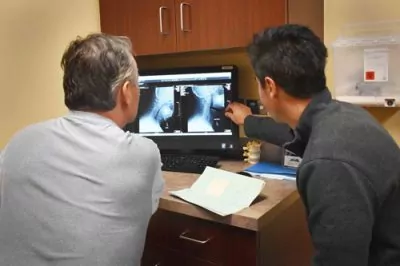Colorado Springs Orthopaedic Group welcomes you
Below you will find some helpful tips on how to prepare for your office visit or surgery and what to expect, including general orthopedic FAQs. If you have any questions, please don’t hesitate to contact us at (719) 632-7669.
What to Expect on Your First Visit
During your initial consultation, your doctor will take your medical history and conduct a comprehensive examination and evaluation of your problem and symptoms. Specifically, your doctor will assess your injury or condition, including range of motion, swelling, muscle and soft tissue weaknesses, and any instability or abnormality present. They will want to know how severe your pain is and how it interferes with your daily activities or participation in sports.

Your doctor will review any previous tests you had, discuss your injury or problem, make a diagnosis, and recommend treatment. If imaging studies are needed to help make a diagnosis, such as X-rays or an MRI, these may be performed in our office the same day.
Some treatments may be performed in our office during your visit, while others may require a subsequent appointment.
Appointment Checklist
The following list will help you prepare for your appointment at CSOG. Please take the time to plan ahead for your appointment so that you get the most out of your visit.
- Print, fill out, and bring relevant paperwork to your appointment (see Patient Forms).
- Bring a valid photo ID to your appointment.
- Call your insurance company to find out about co-pays and other potential coverage issues.
- Make sure you have transportation to and from the doctor’s office.
- Be prepared to tell your doctor how and when you injured yourself. Jot down any specific details such as what you felt or heard at the time.
- Bring a list of all medications you are taking, including any over-the-counter pain relievers, vitamins, and herbal supplements.
- Make a list of questions to ask your doctor.
- Be honest and complete in talking with your doctor. Share your point of view and don’t hold back information.
- Take notes on what the doctor tells you, and ask questions if you don’t understand the meaning of a word or the instructions for taking medication.
- Ask your doctor for handouts or brochures that you and your family members can review at home. Your doctor may refer you to an Internet web site for more information.
At Express Bone & Joint Injury Care we provide walk-in access to highly experienced orthopedic specialists with reduced overall cost and wait time for patients, as opposed to traditional emergency department care.
What to Expect on Your First Visit
We accept Workers’ Compensation, Medicare, and most major insurance plans. If your insurance plan requires you to pay a co-payment, co-insurance, and/or a deductible, you will need to pay at the time of your visit. For your convenience, we accept cash, checks, Visa, MasterCard, and American Express.
Your doctor will review any previous tests you had, discuss your injury or problem, make a diagnosis, and recommend treatment. If imaging studies are needed to help make a diagnosis, such as X-rays or an MRI, these may be performed in our office the same day.

If you have a question related to your bill or insurance, please contact our billing specialists at (719) 867-7346. In the Colorado Springs area, Express Bone & Joint Injury Care is proud to offer patients, new and old, quick access to quality care for musculoskeletal injuries, from being on the workplace to the field of play.
- Download and complete Express Care Paperwork from patient forms
- Walk in to suite 145 – Express Care is to the right
- Check in at front desk
- Efficient, comfortable consultation with provider
- X-ray taken, then an MRI or follow-up appointment will be scheduled as needed
- Discuss an easy to understand treatment plan, designed specifically for you
- Check out with our front desk
Learn more about CSOG
General Orthopedics FAQs
What are the most common orthopedic conditions?
Osteoarthritis affects more than 21 million Americans and is responsible for thousands of yearly hip, knee and shoulder replacements. Back and spine problems also account for a large number of complaints. Other common problems are bursitis, tendonitis, carpal tunnel syndrome, rotator cuff tears, ligament and cartilage injuries, and fractures from sports and motor vehicle accidents.
How can I keep my bones healthy and avoid orthopedic problems?
Bone minerals are composed heavily of calcium. During periods of bone growth, between 10 and 20 years of age, calcium should be a regular dietary component. In addition, individuals begin to lose bone minerals past the age of 35.
Calcium supplements can help minimize this loss. Staying active with regular exercise, maintaining a healthy weight, and eating a healthy diet are also very important for keeping bones and joints healthy.
What is the difference between a sprain and a fracture and how can I tell the difference?
A fracture is a break in a bone that can result from an accident or other injury. If the broken bone punctures the skin, it is called an open or compound fracture.
Fractures commonly happen because of auto accidents, falls, or sports injuries. Other causes are low bone density and osteoporosis, which cause weakening of the bones. Overuse can also cause stress fractures, very small cracks in the bone.
In many fractures, the affected limb looks misshapen and out of place. The limb can become swollen and the fracture may cause severe pain. Other symptoms include bruising, numbness or tingling, and sometimes an inability to move the limb or bear weight.
A sprain is an injury of the ligaments, tissues that connect bones together. When the ligaments are stretched past their normal range of motion, the result can include swelling, severe pain, and limited mobility.
Sprains usually heal with rest, but a fractured bone must be set or surgically repaired to heal. If you have an injury to a limb you should always seek the advice of a medical professional to determine the correct diagnosis.
What causes osteoarthritis?
A layer of tissue, called cartilage, covers the end of the bones at each joint and acts as a shock absorber. Over time, cartilage can wear away, and the joints can become stiff, swollen, and sore. This condition is called arthritis. Arthritis is a leading chronic condition in the US, affecting more than 21 million Americans.
Should I apply ice or heat to an injury?
Ice is a good rule of thumb in the first stage of an injury (within the first 24-48 hours), or whenever there is swelling. Ice helps to reduce inflammation by decreasing blood flow to the area to which cold is applied. Heat increases blood flow and may promote pain relief after swelling subsides. Heat may also be used to warm up muscles prior to exercise or physical therapy.
What actually is physical therapy?
Physical therapy is used to help treat musculoskeletal and neurological injuries to promote healing and a return to normal function after an injury or surgery. Physical therapy helps you regain range of motion, strength, and endurance, thereby helping you to regain normal function. This is achieved through stretching, resistance exercises, and modalities such as heat, cold, ultrasound, and electrical stimulation.
What is a tendon, a ligament, cartilage?
A tendon is a band of tissue that connects your muscles to your bones.
A ligament is a band of tissue that connects bone to bone and provides stability to your joints.
Cartilage is a gel-like padding between your bones that protects joints and allows for movement.
What is a cortisone injection?
Cortisone is a steroid that is produced naturally in the body. Cortisone is also produced synthetically (it is manufactured), and can be injected into soft tissues and joints to help decrease inflammation. While cortisone is not an actual pain reliever, pain may diminish as a result of reduced inflammation.
Cortisone injections are commonly used as a treatment for conditions such as bursitis, tendinitis, and arthritis and can bring great relief to pain sufferers. There are generally limits placed on the number of times an affected area can be injected. You can discuss this with your doctor.
I’m having surgery. What is the difference between sedation and general anesthesia?
There are different levels of anesthesia. There is conscious sedation, deep sedation, and general anesthesia. Conscious sedation is often used in short, uncomplicated procedures. Medications are used to help reduce anxiety and pain. It allows the patient to forget or not feel any discomfort during the surgical procedure. The patient remains somewhat awake and is able to follow verbal instruction.
This type of sedation is often used in conjunction with a local anesthesia that numbs the direct area where the procedure is taking place.
Deep IV (intravenous) sedation uses medications that allow the patient to forget or not feel any discomfort or pain during the procedure. They are able to breathe on their own and respond to deep stimulation, with swallowing and other reflexes still functioning.
General anesthesia puts you into a deep sleep so you do not feel pain during surgery. General anesthesia involves administering certain medicines intravenously (through an IV), so you will not be aware of what is happening around you.
Once you are sedated, the doctor may insert a tube into your windpipe (trachea) to administer anesthetic gases, and to help you breathe and protect your lungs. General anesthesia is administered in a hospital or outpatient center and is generally used for longer procedures or procedures that would cause more pain than can be tolerated with other methods of anesthesia.